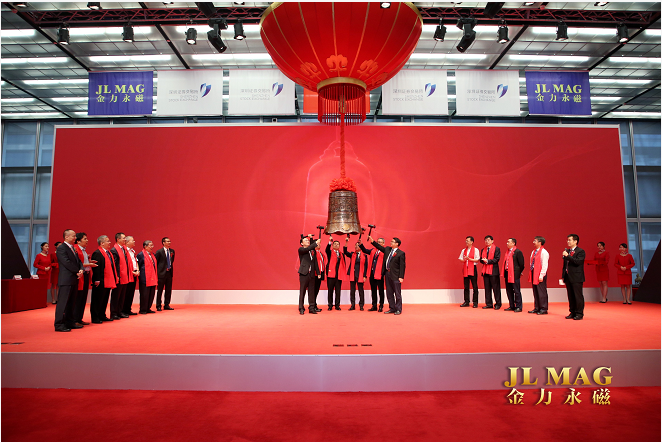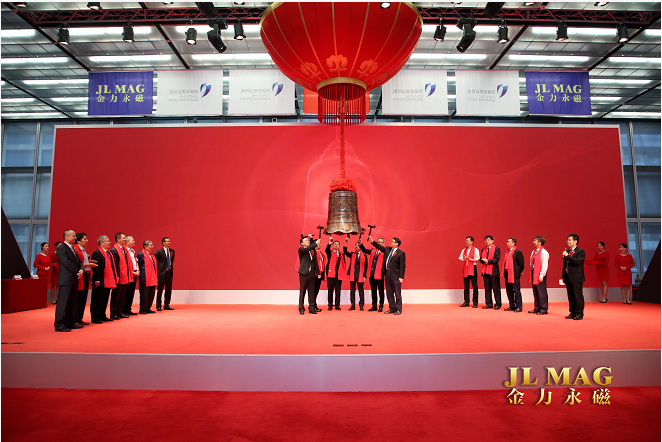
As China strives to weaponize its rare earth advantage in the tariff war with the U.S., this stock could be a beneficiary.

The state-owned maker of rare earth magnets reported strong profit growth in the first quarter, reversing two years of declines
Key Takeaways:
- As a maker of rare earth magnets that are an important component in many high-tech electronics, JL Mag is benefitting from China’s efforts to stimulate consumer spending
- The company’s shares fell sharply after China banned U.S.-bound exports of rare earths, but later rebounded on expectation of strong state support for the strategic sector
It may seem counterintuitive at first — a company’s profitability rising in tandem with the price of its raw materials. Yet in the case of JL Mag Rare-Earth Co. Ltd. (6680.HK; 300748.SZ), that’s exactly what is happening.
In a brief announcement last Thursday, the world’s leading producer of rare earth magnetic materials — widely used in new energy vehicles, wind turbines, and certain air conditioners — said its first-quarter profit rose 50% to 60% year-on-year. Even more strikingly, its net profit after deducting non-recurring items like government grants more than quadrupled, suggesting a strong rebound in its core operations.
The upbeat results were all the more surprising because they came just two weeks after JL Mag released a full-year 2024 earnings report showing its profit for the year fell nearly 50% — a continuation of its declining profitability over the past two years. However, last week’s brief announcement offered little explanation for the sudden improvement.
Some might try to draw a link between JL Mag’s fortunes and China’s status as the world’s leading rare earths producer, and its recent use of the important materials as a bargaining chip in its trade war with the U.S. But the reality behind the big profit jump is more mundane, which we’ll explain shortly.
A look back reveals that JL Mag’s profitability over the years is closely linked to rare earth prices, which peaked in 2022. That year, the company reported increases of 75.6% and 55% in revenue and profit, respectively. But two years later, its net profit fell to just 41% of the 2022 level. Over that period, the prices of rare earths, a collective name for 17 metallic chemical elements, fell at a similar pace.
Such correlation seems to go against common sense – typically, the lower the production costs, the higher the profits margins and actual profits, and vice versa. To understand what happened then and now, it’s important to examine the company’s “cost-plus pricing mechanism” for its core high-performance rare earth magnets that deliver permanent magnetism.
Under this model, JL Mag sets the price of a product by adding a markup to the total cost of production — a common method for manufacturers. While such a mechanism protects manufacturers from raw material price fluctuations, JL Mag has previously noted there are often “lagging adjustments in raw material costs.” In its case, as raw material prices continued to decline over two years, the company lowered its own prices to its customers, even though it often purchased the raw materials months earlier at prices that were still relatively high at that time. That lag effect squeezed its profit margins.
Stabilizing prices
The good news is that rare earth prices finally began to stabilize last year, causing the lag effect to fade. As a result, JL Mag’s profitability has improved steadily since the third quarter of last year, according to its 2024 annual results. This recovery — combined with a low base in the first quarter of 2024 — helps explain the sharp profit improvement in the most recent quarter.
China’s efforts to boost domestic consumption — including subsidies for electric vehicles (EVs) and home appliances, both major users of rare earth magnets — have also helped. In its 2022 prospectus for its Hong Kong IPO, JL Mag noted that average selling prices for rare earth magnets used in certain energy-saving air conditioners — which now account for a growing share of its revenues — are higher due to the need for more precise processing.
In 2024, revenue from energy-saving variable frequency air conditioners (VFACs) accounted for over 26% of the company’s core business, with the segment achieving 61.8% year-on-year growth.
The outlook appears to be improving as rare earth prices rebound and are expected to remain stable, supported by strict government regulation and continued policy support. China’s tightening of rare earth controls — including stricter qualification requirements for industry players and reduced mining and smelting caps last year — has been a major factor in lifting previously sluggish prices.
China’s ongoing commitment to stimulate domestic consumption as it faces mounting economic challenges also bodes well for rare earth magnet sales.
That said, the ongoing trade war with the U.S. and intensifying price wars within China’s EV sector are throwing elements of uncertainty into the sector.
On April 4, China suspended exports of seven rare earth elements following U.S. President Donald Trump’s announcement of sweeping new tariffs. A spokesperson for the Ministry of Commerce said that China’s decision aimed to better safeguard national security and interests, as such elements have both civilian and military applications.
That may be good for China as it uses its dominance in rare earth production as one of its strongest bargaining chips in sparring with the U.S. over their trade relationship. But it may not be quite so good for actual companies in the country’s rare earth industry that sell to the U.S.
China is the dominant global producer of rare earths, and its restrictions on these elements as a trade weapon over the years aren’t exactly new. In 2012, the U.S., Japan and EU filed a case at the World Trade Organization after China drastically reduced its export quotas for rare earths. The WTO ruled against China two years later, leading China to drop the quotas in 2015. After the U.S. restricted chip exports to China in 2023, Beijing responded by banning the U.S. from importing Chinese technology used to produce rare earth magnets.
JL Mag’s revenue from outside China accounted for 20.7% of its core business revenues last year. In a briefing to institutional investors on April 7, the first trading day after China announced its export ban, JL Mag said its revenue from the Americas amounted to around 418 million yuan ($57 million) last year, representing roughly 6% of its total, according to state media People’s Daily. That means revenue from the U.S. only accounts for a small portion of the company’s total, limiting the impact of China’s export restrictions.
JL Mag’s Hong Kong-listed shares fell by about 25% on the first trading day after China announced its ban. However, the stock recovered much of the losses in the following days, showing investors believe the government will support the sector.
JL Mag’s Hong Kong shares currently trade at a relatively high price-to-earnings (P/E) ratio of over 58, though the figure would come down considerably on a forward basis if the company’s profit continues to grow strongly for the rest of this year. That could present a buying opportunity for buyers if the strong profit gains continue, as China looks to protect this valuable industry as one of its most important bargaining chips in its trade war with the U.S.
© 2025 Benzinga.com. Benzinga does not provide investment advice. All rights reserved.

